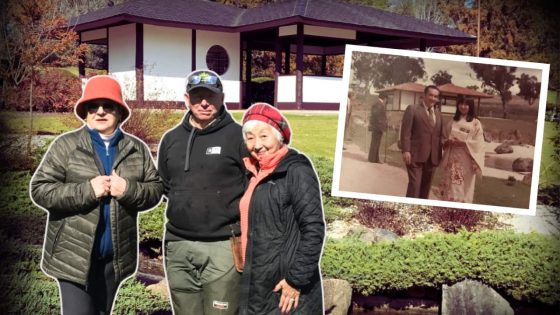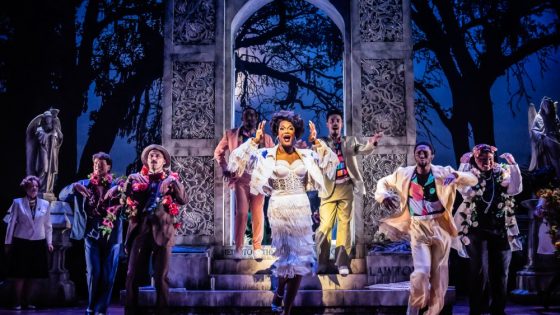Key Points
- The Cowra Breakout occurred on 5 August 1944, resulting in 234 Japanese and four Australian soldiers losing their lives.
- An exchange program between high schools in Cowra and Tokyo was launched in 1970 to nurture understanding.
- Commemorative events have helped old friends rekindle relationships forged 50 years ago.
“I was just told to go and get along well with people there. I didn’t know English well. Then my first host father said to me ‘Maybe it’s about time’ and brought me to the POW campsite and the Japanese cemetery,” she told SBS Japanese.
Noriko Oka with students in Cowra in 1978. Credit: Noriko Oka
Although she initially wondered why there was a Japanese cemetery in a small New South Wales town, the lesson she learned that day stuck with her.
“His daughter, Jennifer Hopkins, had been an exchange student to Seikei [Tokyo] in 1977 and stayed with my family for eight months.”

Noriko Oka (second from the right) in 1978 with her second host family, the Pressers. Credit: Noriko Oka
“He said, ‘Jennifer went to Japan and got along well with people there. Then Noriko, you came here and you will make friends with many people. You don’t have to know what happened in the past now. What matters is we have interactions,’” Oka recalled.
Cultural exchange
It’s considered World War Two’s largest prisoner-of-war escape.

The burial of Japanese prisoners of war who lost their lives in the mass breakout from the camp in Cowra. Credit: AAP Image/Supplied, Australian War Memorial
A series of commemorative events to mark the anniversary have brought together people from near and far, including former exchange students like Oka.
The exchange program between Seikei Junior and Senior High School in Tokyo and Cowra High School started in 1970, before the White Australia policy was formally abolished.
“It wasn’t an easy thing to do at all, I heard. The negative feelings toward Japanese people were so strong that it made Mr Oliver think something needed to be done.”

Noriko Oka (centre) lays a wreath at a ceremony to mark the 80th anniversary of the Cowra Breakout in NSW. Credit: SBS
Believing that a student exchange program might help nurture mutual understanding among young people in Australia and Japan, Oliver contacted the Japanese Embassy in Canberra in 1969.
The embassy referred him to Seikei High School and the program started a year later.
Positive change after tragedy
Jennifer Needham was the first exchange student who departed Cowra in 1970.

Jennifer Needham (second from left) and Harumichi Maeda (right) were part of the Cowra-Seikei exchange program in the 1970s. Credit: SBS
“No computers, no internet, no mobile phones. A 16-year-old girl from a country town arriving in Tokyo,” Needham said, surrounded by fellow former exchange students near Australia’s World Peace Bell in Cowra.
“It was totally amazing and blew my mind. It really changed my whole life. All because of the breakout.”
Who would have thought? All those years ago, something so horrendous and painful. Now we have friendships forged 50 years ago and still growing.
Jennifer Needham
“I’ve been to Cowra at least seven times, I bring my family sometimes. We also celebrate the program’s anniversaries both in Cowra and Tokyo. I have been in contact with my host family for more than 50 years. Currently I’m staying at my host sister’s place,” Maeda said.

The Japanese War Cemetery in Cowra during an event to mark the 80th anniversary of the Cowra Breakout. Credit: SBS
“I watched a film about the Cowra Breakout again before I came here. This was a tragedy and I have sad feelings towards Japanese POWs.
“At the same time, I am so moved and very thankful that Australian people turned the hatred into reconciliation and have been looking after the Japanese cemetery so well.”
Teaching through translation
“One of the things I like about the novel is that Japanese POWs are vividly depicted as young men in their 20s. It was eye-opening. I met some of them (in real life) but they were already grandpas. I forgot they had their younger days, but of course (they did),” Oka said.

Noriko Oka (left) at the gift shop of the Japanese Garden in Cowra, holding a Japanese version of the Australian novel Barbed Wire and Cherry Blossoms written by Dr Anita Heiss. Credit: Noriko Oka
Oka said she met Heiss about seven years ago when the Australian visited Seikei High School in Tokyo.
“I thought, yes, I can do this. I know about the Cowra Breakout and I spent 10 months in Cowra. I know the place,” Oka said.
Lasting friendships
“Each Seikei student usually has four to six host families during their stay in Cowra. If you do the math, many people in Cowra [population less than 13,000] have connections to Seikei students, directly or indirectly.”

Eren Hasegawa (left) and Tsubomi Fujimoto, Japanese students currently on short-term stays in Cowra. Credit: SBS
Oka reflected on the lasting friendships she has made thanks to her student exchange.
“We promised each other to visit Melbourne together four years ago. Then the coronavirus outbreak hit. We were so determined this time to make it happen,” Oka said.
Listen to SBS Japanese Audio on Tue, Thu and Fri from 1pm on SBS 3.
Source Agencies




